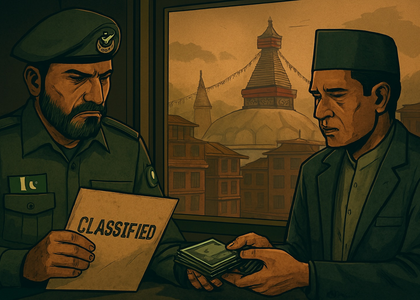Pakistan’s ISI using Nepal to push terror and fake currency into India
By IANS | Updated: August 13, 2025 19:50 IST2025-08-13T19:41:54+5:302025-08-13T19:50:00+5:30
New Delhi, Aug 13 At a recent seminar on challenges to regional peace and security in South Asia ...

Pakistan’s ISI using Nepal to push terror and fake currency into India
New Delhi, Aug 13 At a recent seminar on challenges to regional peace and security in South Asia in Kathmandu, Sunil Bahadur Thapa, Principal Political Advisor to the President of Nepal, said that Pakistan-based UN-designated terrorist groups like the Lashkar-e-Taiba and Jaish pose a risk to India.
He also said that these groups could potentially use Nepal as a transit point for their nefarious objectives.
Nepal, being used as a transit point, is nothing new for Pakistan’s ISI. There are numerous incidents which clearly show that Nepal has been a favourite transit hub for the ISI.
In recent weeks, the Intelligence agencies have flagged the rising operations by the ISI and its elements in Nepal. Counterfeit Indian currency, which was flooded into India through the Bangladesh border, is currently rampant through the Nepal border.
While on one hand, the ISI has been actively carrying out operations in Bangladesh to target India’s northeastern states, on the other it has ramped up action in Nepal as well. Intelligence Bureau assessments suggest that Nepal could become the next front for the ISI to launch its proxy war against India.
While the primary interest of the ISI would always be the Line of Control (LoC) to target Jammu and Kashmir, it has, however, been opening up new fronts. Infiltrations along the LoC are becoming difficult, and the Indian agencies are on a state of very high alert.
The idea is to keep the Indian forces busy on all possible fronts with the hope that security along the LoC becomes stressed and the ISI can get back to its activities along the LoC. Indian officials, however, maintain that the armed forces are prepared to take on the threat from any front, although it would be a challenging and full-time affair.
In addition to trying to strike from the Nepal border, the ISI has also been exploring new infiltration routes here. In the past, too, the ISI has used this route to send in terrorists from Pakistan. However, this time around, the ISI would ramp up activities tenfold, the agencies have warned.
During a recent probe, the National Investigation Agency (NIA) found that there is a massive racket that is on to ramp up the circulation of fake Indian currency. The earlier routes that they were using were through Bangladesh and then into India. The fake currency would either land in Malda in West Bengal before being circulated to different parts of the country.
Today, the fake currency is being pushed into India in large numbers through the Nepal border. Once in India, it is circulated to different parts of the country. One of the primary reasons why the fake currency racket is being ramped up is that the ISI wants to raise funds for terror funding.
India’s Operation Sindoor has been a major setback for the Pakistan-based terror groups. Hence, funds are being raised in a big way to re-do the terror infrastructure that these terror groups lost during the operation that was carried out to avenge the Pahalgam attack.
The Reserve Bank of India (RBI) data also indicates that a large number of counterfeit notes have been detected in India. In 2023, 2,25769 pieces of fake currency were detected. In 2024, the number was 2,22,639.
The worry for the agencies is that this number could go up as Pakistan-based smugglers, along with their counterparts in Bangladesh and Nepal, will make a harder push this year.
Understanding the gravity of the problem, a Terror Funding and Fake Currency Cell has been set up in the NIA to exclusively deal with the menace.
Disclaimer: This post has been auto-published from an agency feed without any modifications to the text and has not been reviewed by an editor
Open in app